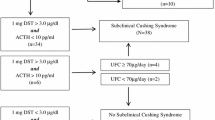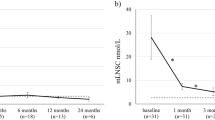Abstract
Introduction
Dehydroepiandrosterone sulfate (DHEA(S)) is a multi-functional steroid implicated in a broad range of biological effects, including obesity, diabetes, bone metabolism, neuroprotection, and anti-tumorigenesis. It has not yet undergone wider research in the context of Cushing’s disease. The objective of this study was to determine if perioperative blood levels of DHEA(S) correlate with levels of ACTH and cortisol, and therefore may be useful as a new, additional marker for the early definition of cure in patients suffering from Cushing’s disease.
Methods
Forty-two consecutive patients undergoing transsphenoidal surgery for Cushing’s disease from September 2009 to September 2010 were perioperatively monitored for ACTH, cortisol, and DHEA(S).
Results
Pre-operative blood samples revealed ACTH levels of median 65 ng/l (range 11–1,183 ng/l, standard deviation 183.76), cortisol of median 257 μg/l (range 93–803 μg/l, standard deviation 140.88), and DHEA(S) of median 2.22 mg/l (range 0.44–7.79 mg/l, standard deviation 1.82) according to the pathology of Cushing’s disease. Postoperative blood samples drawn over a 7-day time span showed a drop in median ACTH to just 14.5 % (median: 9 ng/l, range 2–44, standard deviation 12.75) of its median preoperative figure. Median cortisol levels were reduced to 6.9 % (median: 18 μg/l, range 10–190 μg/l, standard deviation 38.04) of their preoperative values and DHEA(S) levels decreased to 17 % (median: 0.38 mg/l, range 0.05–2.29, standard deviation 0.51). In persistent disease, no patient showed a drop in DHEA(S) below 38 % of its preoperative figures.
Conclusions
DHEA(S) shows the potential to become an additional marker in the diagnosis and follow-up of patients. However, it needs to be examined further, including whether DHEA(S) may also be a useful predictor of recovery of the HPA-axis after successful surgery.


Similar content being viewed by others
References
Barrett-Connor E, Edelstein SL (1994) A prospective study of dehydroepiandrosterone sulfate and cognitive function in an older population: The Rancho Bernardo study. J Am Geriatr Soc 42:420–423
Esposito F, Dusick JR, Cohan P (2006) Clinical review: Early morning cortisol levels as a predictor of remission after transsphenoidal surgery for Cushing’s disease. J Clin Endocrinol Metab 91:7–13
Flitsch J, Knappe UJ, Lüdecke DK (2003) The use of postoperative ACTH levels as a marker for successful transsphenoidal microsurgery in Cushing’s disease. Zentralbl Neurochir 64:6–11
Gordon GB, Bush TL, Helzlsouer KJ, Miller SR, Comstock GW (1990) Relationship of serum levels of dehydroepiandrosterone and dehydroepiandrosterone sulfate to the risk of developing postmenopausal breast cancer. Cancer Res 50:3859–3862
Heald AH, Ghosh S, Bray S, Gibson C, Anderson SG, Buckler H, Fowler HL (2004) Long-term negative impact on quality of life in patients with successfully treated Cushing’s disease. Clin Endocrinol 61:458–465
Hofmann BM, Hlavac M, Martinez R, Buchfelder M, Müller OA, Fahlbusch R (2008) Long-term results after microsurgery for Cushing disease: experience with 426 primary operations over 35 years. J Neurosurg 108(1):9–18
Hunt PJ, Gurnell EM, Huppert FA, Richards C, Prevost AT, Wass JA, Herbert J, Chatterje VK (2000) Improvement in mood and fatigue after dehydroepiandrosterone replacement in Addison’s disease in a randomized, double-blind trial. J Clin Endocrinol Metab 85:4650–4656
Khorram O (1996) DHEA: A hormone with multiple effects. Curr Opin Obstet Gynecol 8:351–354
Kleiber H, Rey F, Temler E, Gomez F (1991) Dissociated recovery of cortisol and dehydroepiandrosterone sulphate after treatment for Cushing’s syndrome. J Endocrinol Invest 14:489–492
Knappe UJ, Lüdecke DK (1996) Persistent and recurrent hypercortisolism after transsphenoidal surgery for Cushing’s disease. Acta Neurochir Suppl 65:31–34
Lacroix AZ, Yano K, Reed DM (1992) Dehydroepiandrosterone sulfate, incidence of myocardial infarction, and extent of atherosclerosis in men. Circulation 86:1529–1535
Locatelli M, Vance ML, Laws ER (2001) Clinical review: the strategy of immediate reoperation for transsphenoidal surgery for Cushing’s disease. J Clin Endocrinol Metab 90:5478–5482
Lüdecke DK, Flitsch J, Knappe UJ, Saeger W (2001) Cushing’s disease: a surgical view. J Neurooncol 54(2):151–166
Lüdecke DK, Niedworok G (1985) Results of microneurosurgery in Cushing’s disease and effect on hypertension. Cardiology 72(suppl 1):91–94
Ram Z, Nieman LK, Cutler GB Jr (1994) Early repeat surgery for persistent Cushing’s disease. J Neurosurg 80:37–45
R Development Core Team (2011) R: A language and environment for statistical computing. R Foundation for Statistical Computing, Vienna, Austria. ISBN 3-900051-07-0, URL http://www.R-project.org/
Sonino N, Zielezny M, Fava GA (1996) Risk factors and long-term outcome in pituitary-dependent Cushing’s disease. J Clin Endocrinol Metab 81:2647–2652
Srinivasan L, Laws ER, Dodd RL, Monita MM, Tannenbaum CE, Kirkeby KM, Chu OS, Harsh GR 4th, Katznelson L (2011) The dynamics of post-operative plasma ACTH values following transsphenoidal surgery for Cushing’s disease. Pituitary 14(4):312–317
Valassi E, Biller BM, Swearingen B, Pecori Giraldi F, Losa M, Mortini P, Hayden D, Cavagnini F, Klibanski A (2010) Delayed remission after transsphenoidal surgery in patients with Cushing’s disease. J Clin Endocrinol Metab 95(2):601–610
Valenti G (2002) Adrenopause: an imbalance between dehydroepiandrosterone (DHEA) and cortisol secretion. J Endocrinol Invest 25(10 Suppl):29–35
Zumoff B, Levin J, Rosenfeld RS, Markham M, Strain GW, Fukushima DK (1981) Abnormal 24-hr mean plasma concentrations of dehydroisoandrosterone and dehydroisoandrosterone sulfate in women with primary operable breast cancer. Cancer Res 41:3360–3363
Conflicts of interest
None.
Author information
Authors and Affiliations
Corresponding author
Additional information
Comment
This is a thought-provoking and interesting article that any surgeon in the Cushing’s field will find of great interest. Where DHEA will take us may prove of importance. It is also worth noting how a center that can find 42 Cushing’s cases in a year and cure the vast majority, can really focus on ways to improve outcome in this dangerous and difficult disease, underlining the often-ignored fact that experience in a rare disease usually improves outcome. Specialist centers really make a difference.
Michael Powell,
London, UK
Rights and permissions
About this article
Cite this article
Burkhardt, T., Schmidt, N.O., Vettorazzi, E. et al. DHEA(S)—a novel marker in Cushing’s disease. Acta Neurochir 155, 479–484 (2013). https://doi.org/10.1007/s00701-012-1596-6
Received:
Accepted:
Published:
Issue Date:
DOI: https://doi.org/10.1007/s00701-012-1596-6




